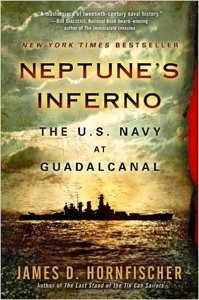Neptune's Inferno: The U.S. Navy at Guadalcanal
This 2011 history is large and was well-received, but I’m not convinced I see the point. A 21st-century history of the US Navy in the Solomons necessarily starts in the shadow of Samuel Eliot Morison’s History of United States Naval Operations in World War II, specifically his Volume 5 on the Guadalcanal campaign. Morison had formidable advantages: he was a Harvard historian, he was a sailor, he had personally met every US president since Teddy Roosevelt and in the war he held a presidential commission to record its naval history. Morison knew the senior officers, he had staff to track down survivors and documents, he was a terrific writer, and he’s still in print.
Hornfischer relies on Morison for a number of anecdotes and accounts. He adds some details and skips some others. He takes pains to emphasize the surface fleet, but Morison is hardly unjust on this score. Hornfischer a little bit more frank in drawing character sketches of the senior officers, but only a little. Morison actually knew these people; Hornfischer has to rely on the record, though Hornfischer need not worry about running into them at parties and reunions.
One problem with Morison, which Hornfischer repeats, is that almost every mistake and shortcoming is committed by the losing side, which in almost every case is the side with the least metal. In August, the US Navy can’t get out of its own way; lookouts don’t look out, radar doesn’t work or is installed in the wrong ships, admirals express themselves poorly. By November, it’s the Japanese navy that has all the bad luck. This is an illusion of causality: the losers remember the inept lookout and the wrong turn as a lost chance, but the winners forget them.
I wonder, for example, whether Ghormley got a raw deal. The contemporary verdict, which Hornfischer largely endorses, is that he was a timid commander, and perhaps a negligent one, a micromanager who approached a nervous breakdown before his relief by Bull Halsey. That could be right, but could you argue that Ghormley was under overwhelming pressure to account for every paper clip, to lose nothing, expend nothing, and above all not to lose?
Hornfischer is critical of Capt. Howard Bode of the Chicago, but Bode’s 1943 suicide makes him a safe target.
If you’re going to write a new account of Guadalcanal, it seems to me you need to take advantage of our more distant perspective. In 1949, the emphasis was naturally on violence and suffering, because the audience had been there or had known people who were there, and they wanted to know what it was like. Today, we might spend a little more time on why and how. All those freighters and support ships, base personnel and clerks were indispensable. That was a tough sell in 1949, but now we’ve all seen Mr. Roberts (about a freighter) and 12 O’Clock High (company clerk) and The Caine Mutiny (junior officer on a minesweeper that never sweeps a mine). Remember: they didn’t have computers or calculators; they didn’t even have ball-point pens.
The other thing you could do in a new account is to recognize that today’s audience doesn’t necessarily know the difference between a light cruiser and a destroyer, what either was supposed to do or how they did it. We’re almost half as far from Guadalcanal as Guadalcanal lay from Trafalgar. We also understand how the stereotyped language of gallant sailors and heroic deeds can mask the ghastly reality, and to look more squarely at some less-than-noble actions from which Hornfischer still prefers to glance away as soon as he decently can.
